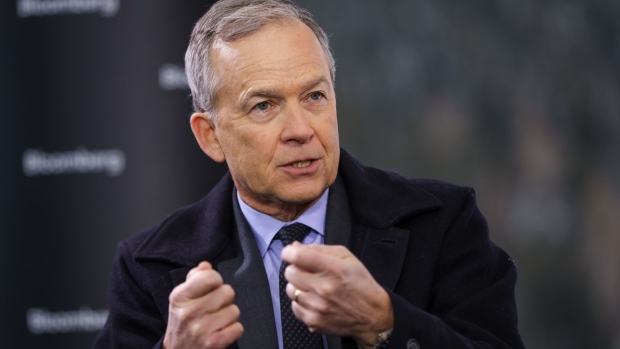風蕭蕭_Frank
以文會友橋水警告美國通脹鬥爭遠未結束
July 14, 023
https://www.ft.com/content/3489c43d-83ff-413b-9477-dd6c042211f2
聯合投資主管鮑勃·普林斯表示,美聯儲不太可能實現市場預期的快速降息

鮑勃·普林斯表示,緊縮政策“可以采取在麵對降息預期時保持利率穩定的形式”。
全球頂級對衝基金之一的投資主管警告稱,美國與通脹的鬥爭遠未結束,押注美聯儲明年一係列快速降息還為時過早。
橋水聯合首席投資官鮑勃·普林斯(Bob Prince)的言論給本周全球股市和債市的漲勢潑了一盆冷水,數據顯示美國年度通脹率已降至兩年多低點,引發了這一漲勢。 6 月份為 3%。
管理著1250億美元資產的橋水基金的普林斯表示,市場認為美聯儲將很快放鬆貨幣政策的假設是錯誤的。 “美聯儲不會降息,”他告訴英國《金融時報》。 “他們不會按照定價去做。”
期貨市場的定價表明,投資者預計到秋季,美聯儲的利率目標範圍將在 5% 至 5.25% 的基礎上進一步上調 0.25 個百分點。 他們預計央行將在接下來的 12 個月內扭轉局麵,到 2024 年 11 月將借貸成本削減六倍至 3.8% 左右。
在本周的通脹數據公布後,交易員加大了對降息的押注。 盡管總體通脹率大幅下降,但核心通脹率(不包括波動較大的食品和能源行業,受到美聯儲密切關注)下降速度較慢,降至 4.8%。 尤其是核心利率仍遠高於美聯儲 2% 的既定目標。
普林斯表示:“通脹已經下降,但仍然過高,而且可能會趨於平穩——我們可能會陷入這個通脹水平。” 他補充說,“目前最大的風險是,當工資仍然強勁時,能源價格就會反彈”,這可能會推動通脹反彈。
Prince 與聯席首席信息官 Karen Karniol-Tambour 和 Greg Jensen 一起負責這家康涅狄格州公司的資產管理,他表示,他認為核心通脹率可能會觸底反彈至 3.5% 至 4% 之間,從而推動美聯儲進一步收緊貨幣政策,令投資者失望。 他本周將美國股市推至一年多以來的最高水平。
他表示,緊縮政策“可以采取在降息預期下保持利率穩定的形式”。
對美聯儲將很快結束其曆史性緊縮周期的預期推動了全年市場的樂觀情緒。 美國兩大股指——標準普爾 500 指數和以科技股為主的納斯達克綜合指數——今年已脫離熊市,分別上漲 16.5% 和 33%。 債券回報率更加低迷,彭博全球綜合指數今年上漲了2.4%,但投資者因希望美聯儲緊縮政策即將結束而鎖定了數十年來的最高收益率。
即便如此,普林斯表示,“目前普遍持有債券或股票資產並不是一個好的環境”,並補充說現金目前是一種有吸引力的選擇。
他表示,橋水基金已經“為緊縮周期做好了準備”,這意味著對風險較高的資產類別采取謹慎立場。
“我們今年的表現接近持平。 一月初我們出現了一些下滑,但從那以後我們已經逐漸恢複過來。” 他沒有討論該公司兩個主要策略的具體業績數據:其 Pure Alpha 基金(傳統的宏觀基金)或其風險平價全天候基金。
普林斯表示,美聯儲將不得不在更長時間內維持較高利率,因為其通脹鬥爭在一定程度上受到強勁勞動力市場的阻礙。 Covid-19大流行初期的財政和貨幣計劃幫助增加了家庭儲蓄,但也使勞動力市場收緊,導致工資大幅上漲。 這意味著美國消費者的收入更高,使他們能夠繼續承受價格上漲的影響。
普林斯表示:“目前的支出水平是由收入提供資金,而不是信貸擴張。” “所以通貨膨脹確實很難降低。”

布裏奇沃特王子表示,必須減少更多工作崗位才能抑製通貨膨脹
Nishant Kumar 和 Lisa Abramowicz,彭博新聞
1 月 17 日,鮑勃·普林斯 (Bob Prince) 在達沃斯。攝影師:Hollie Adams/Bloomberg
1 月 17 日,鮑勃·普林斯 (Bob Prince) 在達沃斯。攝影師:Hollie Adams/Bloomberg, Bloomberg
(彭博社)——幫助管理全球最大對衝基金的鮑勃·普林斯(Bob Prince)表示,我們正在看到繁榮-蕭條周期的回歸,在通脹得到控製之前,需要有更多的人失業。
橋水聯合首席投資官普林斯在瑞士達沃斯世界經濟論壇上接受彭博電視采訪時表示,“很難說我們是否已經結束緊縮政策,或者是否還會再次緊縮政策。” “我們可以說的是,下一個落腳點必定是經濟下滑,特別是勞動力市場收縮。”
普林斯表示,交易員的表現仍然像是美聯儲將重複對之前經濟低迷的反應,從而提振股價。 “被低估的是對過去十年的回歸,”他說。 “實際發生的情況更像是 20 世紀 70 年代。 更像是繁榮-蕭條周期。”
他的預測與包括花旗集團的簡·弗雷澤(Jane Fraser)在內的一些首席執行官在達沃斯其他地方關於溫和衰退前景的言論背道而馳。 不過,普林斯表示,經濟衰退的深度將取決於央行在多大程度上遏製通脹,以及企業在多大程度上控製自己的支出。
繁榮-蕭條周期是指經濟擴張和收縮不斷重複。 自金融危機以來央行的幹預以及過去十年大部分時間的貨幣寬鬆打破了這種模式並推動了市場繁榮。 普林斯本人在 2020 年達沃斯發表講話時表示,繁榮-蕭條的經濟周期已經結束。
“我們正在經曆美國和歐洲經濟貨幣刺激的後遺症。 現在,錢在係統中旋轉,從一個人到另一個人,”普林斯說。 “支出根本沒有下降,還不足以降低通脹。”
這家總部位於康涅狄格州韋斯特波特的投資公司的 Pure Alpha II 基金在 10 月和 11 月因市場轉向而損失了大部分年度收益後,去年收盤上漲了 9.5%。
Bridgewater's Prince Says More Jobs Must Vanish to Tame Inflation
Nishant Kumar and Lisa Abramowicz, Jan 17, 2023

Bob Prince in Davos on Jan. 17. Photographer: Hollie Adams/Bloomberg , Bloomberg
(Bloomberg) -- Bob Prince, who helps manage the world’s largest hedge fund, said we're seeing the return of the boom-bust cycle and more people need to lose their jobs before inflation will be brought under control.
“It is hard to say whether we are done with the tightening or we will have another tightening,” Prince, the co-chief investment officer of Bridgewater Associates, said in an interview with Bloomberg TV at the World Economic Forum in Davos, Switzerland. “What we can say is that the next shoe to drop has to be a decline in the economy, in particular, a contraction in the labor markets.”
Prince said traders were still acting like the Federal Reserve will repeat its response to previous downturns and therefore buoy stock prices. “What is discounted is a return to the last decade,” he said. “What is actually happening is more like the 1970s. More like the boom-bust cycle.”
His predictions run counter to what some CEOs including Citigroup Inc.’s Jane Fraser have been saying elsewhere at Davos about the prospects of a mild recession. Still, Prince said the depth of any downturn will depend on how far central banks go to counter inflation, and how much companies rein in their own spending.
The boom-bust cycle refers to economic expansion and contraction that repeats itself. Central bank intervention since the financial crisis and monetary easing for much of the last decade had disrupted that pattern and fueled a market boom. Speaking at Davos in 2020, Prince himself had said that boom-bust economic cycle was over.
“We are experiencing the after effects of the monetary stimulation of the US and European economies. Now the money is spinning around the system, exchanging hands from one to the next,” Prince said. “Spending has not fallen off hardly at all, not nearly enough to bring down inflation.”
The Westport, Connecticut-based investment firm’s Pure Alpha II fund ended last year up 9.5%, after losing much of its annual gains in October and November as markets turned.




